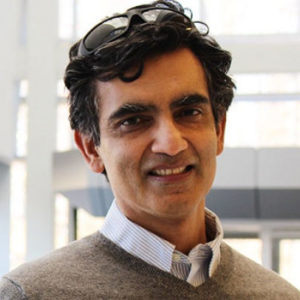Free energy plays a fundamental role in theories of phase transformations and microstructure evolution. It encodes the thermodynamic coupling between different fields, such as mechanics and chemistry, within continuum descriptions of non-equilibrium materials phenomena. In mechano-chemically interacting materials systems, even consideration of only compositions, order parameters and strains results in a free energy description that occupies a high-dimensional space. Scale bridging between the electronic structure of a solid and continuum descriptions of its non-equilibrium behavior can be realized with integrable deep neural networks (IDNN) that are trained to free energy derivative data generated by first-principles statistical mechanics simulations and then analytically integrating to recover a free energy density function.

Prof. Krishna Garikipati’s team combines the IDNN with an active learning workflow to ensure well-distributed sampling of the free energy derivative data in high-dimensional input spaces, thereby enabling true scale bridging between first-principles statistical mechanics and continuum phase field models. As prototypical material systems, they focus on applications in Ni-Al alloys and in the battery cathode material: LixCoO2. Cahn-Hilliard and Allen-Cahn phase field simulations using the resulting IDNN representation for the free energy density of Ni-Al demonstrate that the appropriate physics of the material has been learned. This work advances the treatment of scale bridging, starting with electronic structure calculations and proceeding through statistical mechanics to continuum physics. Its coupling of Cahn-Hilliard and Allen-Cahn phase field descriptions with nonlinear elasticity through the free energy density ensures a rigorous treatment of phase transformation phenomena.
Krishna Garikipati obtained his Ph.D. at Stanford University in 1996, and after a few years of post-doctoral work, he joined the University of Michigan in 2000, where he is now a professor in the Departments of Mechanical Engineering and Mathematics.
Since 2016 he also has served as the director of the Michigan Institute for Computational Discovery & Engineering (MICDE). His research is in computational science, with applications drawn from materials physics, biophysics, mechanics and mathematical biology. Of recent interest are data-driven approaches to computational science.
He has been awarded the DOE Early Career Award for Scientists and Engineers, the Presidential Early Career Award for Scientists and Engineers (PECASE), and a Humboldt Research Fellowship. He is a fellow of the US Association for Computational Mechanics, a Life Member of Clare Hall at the University of Cambridge, and a visiting scholar in Computational Biology at the Flatiron Institute of the Simons Foundation.